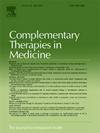Language function improvement and cortical activity alteration using scalp acupuncture coupled with speech-language training in post-stroke aphasia: A randomised controlled study
IF 3.3
3区 医学
Q1 INTEGRATIVE & COMPLEMENTARY MEDICINE
引用次数: 0
Abstract
Background
Scalp acupuncture is commonly used as a complementary treatment to improve language function in patients with post-stroke aphasia. Our objectives were to evaluate the impact of scalp acupuncture on the cerebral cortex of post-stroke aphasia patients.
Methods
This assessor-blinded, parallel-arm design, single-center, randomized clinical trial recruited 64 patients with post-stroke aphasia. They were randomly assigned to either the acupuncture group (n = 32) or the control group (n = 32). The primary outcome measure was the Western Aphasia Battery (WAB) score, while the secondary outcome was the oxygenated haemoglobin (OxyHb) index, which represents cortical activity as measured by functional near-infrared spectroscopy (fNIRS). All assessments were performed at baseline and post-intervention.
Results
The acupuncture group showed significant improvements in WAB subscales (Spontaneous Speech, Comprehension, Repetition, Naming, and AQ) with all changes statistically significant (P < 0.001). The acupuncture group also showed higher OxyHb indices in the left frontopolar area, left fusiform gyrus, and left pars opercularis (P < 0.05). Additionally, OxyHb D-values were significantly greater in the left frontopolar area and right superior temporal gyrus (P < 0.05) compared to the control group. Among non-global aphasia patients, acupuncture improved comprehension and naming tasks, with lower OxyHb in the right visual association cortex and angular gyrus (P < 0.05). In global aphasia patients, improvements were seen in the AQ and Repetition scores, with higher OxyHb in the right inferior prefrontal gyrus (P < 0.05).
Conclusion
Adjuvant scalp acupuncture enhances the effectiveness of speech-language therapy in treating repetition and naming impairments in patients with post-stroke aphasia. Additionally, it may modulate cortical activation in the left frontopolar area, left fusiform gyrus, left pars opercularis, and right superior temporal gyrus, and induces different cortical alteration patterns in global and non-global aphasia.
脑卒中后失语症的语言功能改善和皮层活动改变:一项随机对照研究。
背景:头皮针刺是一种常用的辅助治疗方法,可改善脑卒中后失语症患者的语言功能。我们的目的是评估头皮针刺对脑卒中后失语症患者大脑皮层的影响。方法:本评估盲、平行设计、单中心、随机临床试验招募了64例脑卒中后失语症患者。他们被随机分配到针灸组(n=32)和对照组(n=32)。主要指标是西方失语电池(WAB)评分,而次要指标是氧合血红蛋白(OxyHb)指数,它代表了fNIRS测量的皮质活性。所有评估均在基线和干预后进行。结果:针刺组在WAB亚量表(自发言语、理解、重复、命名、AQ)上均有显著改善,差异均有统计学意义(P < 0.001)。针刺组左额极区、左梭状回、左包部的OxyHb指数均高于针刺组(P < 0.05)。此外,与对照组相比,左额极区和右颞上回的OxyHb d值显著升高(P < 0.05)。在非全能性失语症患者中,针灸改善了理解和命名任务,降低了右侧视觉关联皮层和角回的OxyHb (P < 0.05)。整体失语症患者的AQ和Repetition得分均有改善,右额叶下回的OxyHb较高(P < 0.05)。结论:辅助头皮针刺可提高语言疗法治疗脑卒中后失语症患者重复和命名障碍的疗效。此外,它还可能调节左侧额极区、左侧梭状回、左侧包部和右侧颞上回的皮层激活,并在全局性和非全局性失语症中诱发不同的皮层改变模式。
本文章由计算机程序翻译,如有差异,请以英文原文为准。
求助全文
约1分钟内获得全文
求助全文
来源期刊

Complementary therapies in medicine
医学-全科医学与补充医学
CiteScore
8.60
自引率
2.80%
发文量
101
审稿时长
112 days
期刊介绍:
Complementary Therapies in Medicine is an international, peer-reviewed journal that has considerable appeal to anyone who seeks objective and critical information on complementary therapies or who wishes to deepen their understanding of these approaches. It will be of particular interest to healthcare practitioners including family practitioners, complementary therapists, nurses, and physiotherapists; to academics including social scientists and CAM researchers; to healthcare managers; and to patients. Complementary Therapies in Medicine aims to publish valid, relevant and rigorous research and serious discussion articles with the main purpose of improving healthcare.
 求助内容:
求助内容: 应助结果提醒方式:
应助结果提醒方式:


